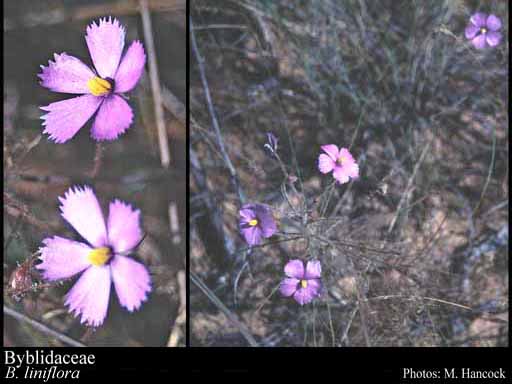- Reference
- Acta Bot.Bohem. 1:3 (1922)
- Name Status
- Current

Scientific Description
Common name. Byblis Family.
Habit and leaf form. Sub shrubs, or herbs. ‘Carnivorous’. Trapping mechanism passive. The traps consisting of the sticky-glandular, non-irritable (flypaper-like) leaves. Leaves alternate; spiral; non-sheathing; simple; epulvinate. Leaf blades entire; linear. Leaves without stipules. Vernation circinnate; circinnate. Stem anatomy. Secondary thickening absent.
Reproductive type, pollination. Fertile flowers hermaphrodite. Unisexual flowers absent. Plants hermaphrodite.
Inflorescence and flower features. Flowers solitary (axillary); ebracteate; regular; 5 merous; cyclic. Free hypanthium absent. Perianth with distinct calyx and corolla; 10; 2 -whorled; isomerous. Calyx 5; 1 -whorled; gamosepalous (basally); imbricate; regular; persistent. Corolla 5; 1 -whorled; gamopetalous (the petals cuneate, shortly connate basally); imbricate, or contorted; regular. Corolla members apically fringed, or entire (B. gigantea). Androecium 5. Androecial members free of the perianth, or adnate (to the base of the corolla tube); all equal, or markedly unequal (sometimes declinate); free of one another; 1 -whorled. Androecium exclusively of fertile stamens. Stamens 5; isomerous with the perianth; oppositisepalous; all alternating with the corolla members; erect in bud, or inflexed in bud. Anthers connivent; basifixed; non-versatile; dehiscing via pores, or dehiscing via short slits (the openings confluent over the anther tip); tetrasporangiate. Gynoecium 2 carpelled. The pistil 2 celled. Gynoecium syncarpous; eu-syncarpous; superior. Ovary plurilocular; 2 locular. Styles 1. Stigmas 1; capitate. Placentation axile. Ovules 10–50 per locule (? — ‘many’); anatropous.
Fruit and seed features. Fruit non-fleshy; dehiscent; a capsule. Capsules loculicidal. Dispersal unit the seed. Seeds endospermic. Cotyledons 2. Embryo straight. Seedling. Germination phanerocotylar.
Physiology, biochemistry. Aluminium accumulation not found.
Geography, cytology, number of species. World distribution: Northern and South-western Australia, New Guinea. 3 species.